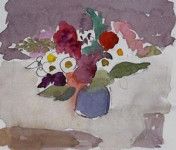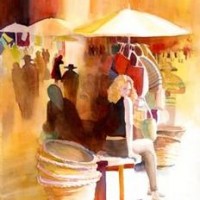
At Corona del Mar, Brandt painting at the top
Unfortunately, I cannot longer offer this class. I have left it here so that it might possibly spark your interest in the 2oth century watercolor masters, with whom I was so fortunate to study, Ed Whitney, Rex Brandt and Miller Sheets among others.
Working with the Masters in Watercolor
I had the good fortune to study with a number of the important teachers and watercolorists of the 20th century. She has chosen the giants Ed Whitney, Rex Brandt and Millard Sheets to share with you — passing on some their lasting contributions to watercolor as well as sharing with you some of her observations and memories. Besides her presentation, links to their works are listed so that those interested can learn more about these masters.
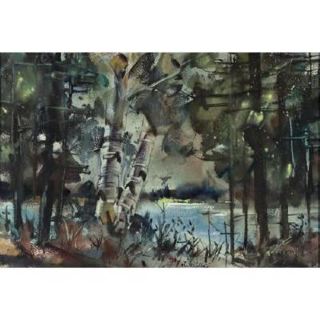 The assignments will help you with your own painting and ground you in some of the most important concepts that made watercolor the American medium in the 20th century.
The assignments will help you with your own painting and ground you in some of the most important concepts that made watercolor the American medium in the 20th century.
The course includes:
Ed Whitney, who changed my life and the way I painted
- planning for a painting
- working wet following the plan and layering wet to dry

Rex Brandt, my artistic “father;” and mentor
- quotes from my notes
- the hierarchy of looking — 2 exercises
- two shadow shape two-value drawings
- simplified value painting
- role of gradation
Millard Sheets, the master of color; also a good friend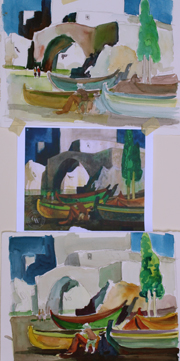
- one design, 3 pairs, six paintings exploring the compositional role of value, intensity and temperature
- one design with two possible focuses; using the properties of color (same hues) the focus is changed from one in the 1st painting to the other in the second painting.
You need to have had Watercolor Basics or are familiar with the processes of watercolor before taking this course. It is a tough course that clarifies for the student some very important aspects of design and color — as taught by the masters. It also gives you a historical perspective on the development of watercolor as the American medium during the later 20th century.
We meet as you progress, on Zoom, to review you work. You photograph it, put it on your desktop and we discuss it via screen share or you send it as an attachment and look at it together on my screen.
Those who have taken it have been very excited about what they have learned. The average number of hours students who took the course for credit put in on the The Inspiration of the Masters is between 50 and 60 hours.

 Left: shadow shape drawing aka Rex Brandt of the Orcas ferry landing + photos taken that day and the painting in his late style, done on location the following summer.
Left: shadow shape drawing aka Rex Brandt of the Orcas ferry landing + photos taken that day and the painting in his late style, done on location the following summer.
Right: Watermelon Lady by Millard Sheets. Study the use of reds in composing this painting.
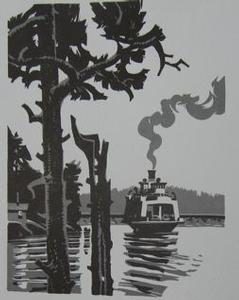
Lino print by Rex Brandt, simplifying values
Equipment:
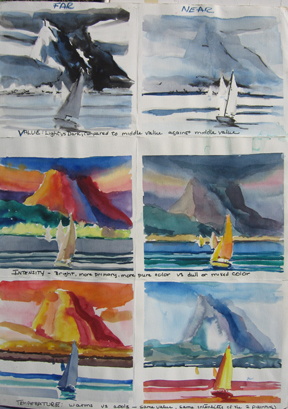
Teaching aid using a concept learned from Millard Sheets.
Please check with me if you have other equipment you prefer. You do not need the list of paints but please get Artist quality of whatever pigments you choose. I strongly recommend the Arches paper. It is the most forgiving. And there are decent brushes that are not too expensive. Don’t shoot yourself in the foot by using poor quality supplies! Longer equipment discussions are included in the individual courses.
es.
Suggested equipment:
D’ARCHES WATERCOLOR PAPER, cold press, 90 or 140 lb.
#2 or 2B pencil
white eraser
2 pint or quart sized water containers
a roll of tissue
1″ clear-handled flat brush — such as WINSOR NEWTON or DANIEL SMITH (72-99) BRUSH
#10 pointed round brush — such as ROBERT SIMMONS #10 or Skyflow, white sable 785
LIDDED PALETTE — such as Aqua Pro, or John Pike, or Steve Quiller’s with at least:
•yellow
•red
•blue
• burnt orange or burnt sienna
• a violet
in artist grade watercolor paint such as Daniel Smith, Winsor Newton, Da Vinci, Holbein.

Millard Sheets, 1985
Arrange your paints in a color wheel (ie rainbow).
I use Daniel Smith colors. Assuming you do not want to buy them all, besides the 6 listed above, first consider the hues highlighted in bold.
cobalt green
pthalo green, or Winsor green
cobalt teal blue
cerulean blue
pthalo blue, or Winsor blue
ultramarine blue
cobalt blue
ultramarine violet
quinacridone violet
quinacridone red or perylene red
quinacridone rose
cadmium red medium
Indian red
quinacridone burnt orange (or sienna)
perinone orange
quinacridone gold
cadmium yellow light, or Winsor yellow, or Hansa
aureolin
green gold
Note: you do not want browns, blacks, white. The paper is the white and we mix luscious browns, blacks etc.
a large flat brush such as an 1 1/2″ or 2″ or larger.SKYFLOW is good but not necessary.
Hairdryer.
A lightweight board
tape or clips


